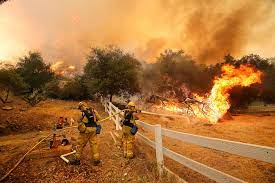Latest reports show that wildfires that blazed around the world in 2024 helped to drive a record annual leap in carbon dioxide levels in the atmosphere, surprising scientists.
The data shows humanity is moving yet deeper into a dangerous world of supercharged extreme weather. The CO2 level at the Mauna Loa observatory in Hawaii jumped by 3.6 parts per million (ppm) to 427ppm, far above the 280ppm level before the large-scale burning of fossil fuels sparked the climate crisis. The Mauna Loa observations, known as the Keeling curve, began in 1958 and are the longest running direct measurements of CO2.
The sharp rise resulted from burning forests adding to continued emissions from coal, oil and gas, which also set a record in 2024. The natural El Niño climate cycle also contributed, by delivering hotter and drier conditions in the tropics. A record rise would probably have occurred even without El Niño though, the scientists said.
The global average temperature also set a new record in 2024, worsening the extreme heatwaves, storms and floods that affected billions of people. This meant the planet passed the 1.5C (2.7F) level agreed as a target by the Paris climate agreement for the first time. The UN secretary general, António Guterres, blamed the fossil fuel industry for pocketing profits while their products “wreak havoc”.
The 1.5C limit is a long-term target and is broken when that level of heat is sustained for a decade or more. Scientists said the rise in CO2 levels in 2024 was incompatible with keeping below the target. The CO2 rise in 2025 is predicted to be lower, but still far above the level needed to be on track for 1.5C.
Read also:UK accused of undermining democratic rights with climate protest crackdown
“This is obviously bad news,” said Prof Richard Betts at the UK Met Office, whose team analysed the CO2 rises. “But even if it looks like we won’t meet the ambitious Paris goal of 1.5C, it is still worth making every effort to limit the rise. 1.5C is not a cliff-edge after which all is lost. There are lots of solutions already available without any new inventions. This must be extra motivation to work even harder.”
Global heating rises continuously as emissions rise, meaning every tonne of CO2 saved reduces human suffering, and the solutions to cut carbon exist. The Guardian revealed in May, however, that most climate experts expect the world to heat far beyond the 1.5C limit and blame political inaction.
Wildfires released billions of tonnes of CO2 in 2024, particularly in the Americas, and the climate crisis increased the severity and frequency of these fires. El Niño also played a part, but wildfires also raged after it had ended and in regions not affected by the climate phenomenon, such as Canada.
El Niño also contributed to the record rise in CO2 because the hot, dry conditions it brings limits the plant growth which removes some human-generated CO2 from the atmosphere.
The 3.6ppm CO2 rise in 2024 was double the 1.8ppm level consistent with a path to net zero emissions and limiting global heating to 1.5C, Betts said. It was also above the Met Office prediction for 2024 of 2.8ppm, probably the result of emissions from wildfires reaching Mauna Loa. The Met Office prediction for 2025 is 2.3ppm as El Niño’s opposite phase, La Niña, encourages more vegetation growth.
Story was adapted from the Guardian.
